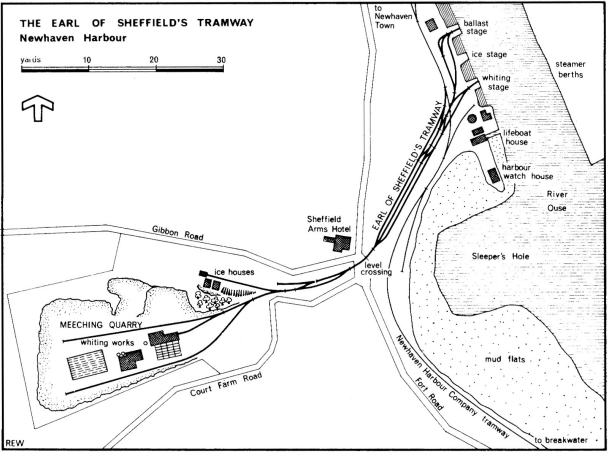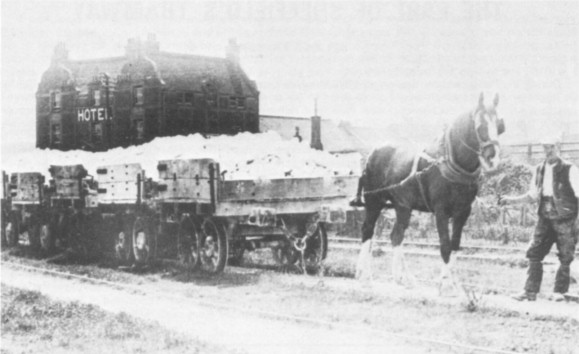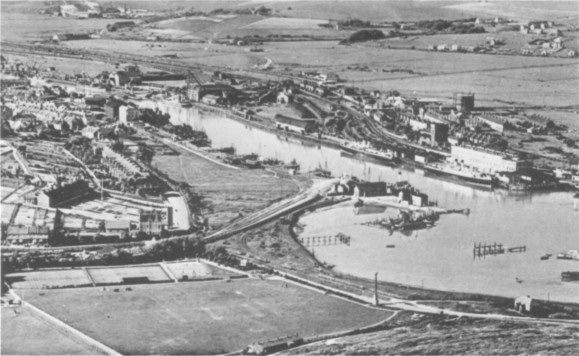
| THE INDUSTRIAL RAILWAY RECORD |
© NOVEMBER 1973 |
THE EARL OF SHEFFIELD'S TRAMWAY
ALLAN J. PARSONS
During the Parliamentary Session of 1878 the Newhaven Harbour Company in Sussex sought a Bill for an Improvement Act which would allow them to lay down a tramway to connect a proposed Breakwater (on the western side of the harbour) with their main railway system. The course of this tramway ran through certain lands in the Parish of Meeching (otherwise Newhaven) belonging to the Earl of Sheffield. Initially the Earl objected to this Newhaven Harbour Improvement Act but under an agreement he made on 21st March 1878 with the promoters of the Act he withdrew his opposition to the Bill. In return he was allowed to build a tramway (from any part of his estate) for conveying chalk and other materials down to the waterside which was owned by the Newhaven Harbour Company.
Eventually the Earl built such a tramway, half a mile long, from his chalk pit to three unloading stages on the river. The chalk carried down the tramway was discharged at these stages into sailing ships (after they had been unloaded at Newhaven) for use as ballast. The line itself, of standard gauge, consisted of rails spiked directly onto sleepers: where it crossed Fort Road a flag was displayed, but there were no gates nor was a crossing keeper employed.
In 1882 the firm of Colgate & Gray bought the chalk pit from the Earl of Sheffield. (Mr H. Colgate had been the steward of the Earl of Sheffield's estates.) The land between the chalk pit and the riverside was sold to the Newhaven Harbour Company but the tramway rights were retained. Besides the export of chalk as ballast, whiting was shipped to Lancaster for Williamsons Ltd. This traffic consisted of about four shipments per year, each of about 250 tons. The whiting was made from chalk which was blasted from the quarry side, then loaded into narrow gauge skips, and taken to a crusher. Here it was ground up in water to a slurry and left to settle in troughs. When dry it was broken up and put in drying racks to harden as whiting, which was used in the manufacture of linoleum. The very last shipment made coincided with the outbreak of War on 3rd September 1939.


A train of chalk wagons on the Earl of Sheffield's tramway, in the charge of Mr H. Breeds. The Sheffield Arms Hotel is in the background. (collection A.J. Parsons)
For the export of chalk and whiting 3‑ton wooden wagons with dumb buffers and iron straps were used. After being loaded they were sheeted over and marshalled at the riverside into trains pending the arrival of a vessel. They had a very short wheelbase and were unusual in the fact that they were designed for end tipping, having one end hinged. At the unloading stages the ends of the rails were bent in the form of a U shape. To load a vessel the horse would gallop to the loading stage pulling a single wagon: it would then be released by pulling a cord which uncoupled the wagon. The wagon then moved forward under its own momentum until the wheels of the leading axle entered the U shape depression in the rail. At this point the wagon body would tip forward, discharging its load into the hold of the ship by means of a drawbridge type chute. At the last moment before the wagon body upturned a safety catch was hooked on the wagon to stop it dropping into the ship's hold. It was a sight never to be forgotten. On one occasion a loaded wagon in the charge of Mr Arthur White was deposited complete with its load into the hold of the vessel! There is no record of the horse being injured.
In all there were about ninety wagons and three horses used on the tramway. During the 1930's the three horses were "Captain", "Colonel" and "Prince" and were in the charge of Messrs White, Breeds and Mapston. Mr Crooks, the foreman, was later succeeded by Mr Breeds. Mr Flint was the Engineer and Mr Eldridge the blacksmith. "Colonel", driven by Mr Head, was the last horse used by Colgate & Gray. The horses, incidentally, were also used to haul the breeches buoy equipment for H.M. Coastguards when there was an emergency at sea.
From the very start a connection was made with the London Brighton & South Coast Railway via the Newhaven Harbour Company's tramway, and box wagons loaded with whiting, hearth stones and putty were taken away by the Harbour Company's "Terrier". (See pages 265 and 266 of RECORD 44.)

Newhaven Harbour, about 1930, looking upstream. The course of the tramway can just be discerned to the left of Sleeper's Hole, in the centre of the photograph. (collection H.A. Gamble)
Besides the export of chalk and whiting, ice was imported in the spring from the Frisches Haff and Kurisches Haff in the Gulf of Danzig on the Baltic Sea. (On modern maps these places are shown as Zalen Wislany and Kurkiy Zaliv.) The ice, in 3ft cubes, was stored in "Ice Houses" or "Ice Wells" which stood at the back of the present Gibbon Road. These houses, at one time in the charge of Mr H. Dyer, were built into the chalk hillside and were extended at the back into caves in the chalk. They were shaded by a grove of trees and had doors facing north. The ice was sold all over Sussex to fishmongers, butchers and hoteliers and was delivered by horse and cart. Ice imports ceased before September 1914.
At the outbreak of World War 2 the shipping trade suddenly ceased and the tramway lay neglected and overgrown until 1948 when an agreement was made with British Railways to abandon it, although BR took over the loading stages for their own use. (Hitherto it had been the responsibility of Messrs Colgate & Gray to repair and maintain the decking of the stages while the Harbour Company (later BR) was responsible for the piling.) No trace can be seen of the tramway today, the site of part of the trackbed now being covered by the Cresta Marine Boat Park. The offices were demolished to make a site for the Marine Court Flats, and the only reminder of the tramway is the nearby Sheffield Arms Hotel. All the wagons used on the tramway were eventually broken up, their wheels and axles going for scrap while their timber parts were burnt.
In conclusion I wish to thank Messrs. H. Gamble, A. Howard and A. White for the information and help they have given me in the preparation of this article.
' .... the Lens and Douvrin concessions (in the Department of the Pas de Calais), worked by the Société des Mines de Lens, [have] fifty-six workable seams and twelve winding shafts, with 80 kiloms. (50 miles) of normal-gauge railways, served by twenty-three locomotives, with 973 wagons ....' ("Colliery Guardian," 29th September 1893. — JKW)